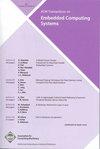Coupling bit and modular arithmetic for efficient general-purpose fully homomorphic encryption
IF 2.8
3区 计算机科学
Q2 COMPUTER SCIENCE, HARDWARE & ARCHITECTURE
引用次数: 0
Abstract
Fully Homomorphic Encryption (FHE) enables computation directly on encrypted data. This property is desirable for outsourced computation of sensitive data as it relies solely on the underlying security of the cryptosystem and not in access control policies. Even though FHE is still significantly slower than unencrypted computation, practical times are possible for applications easily representable as low-order polynomials, since most FHE schemes support modular addition and multiplication over ciphertexts. If, however, an application cannot be expressed with low-order polynomials, then Boolean logic must be emulated. This bit-level arithmetic enables any computation to be performed homomorphically. Nevertheless, as it runs on top of the natively supported modular arithmetic, it has poor performance, which hinders its use in the majority of scenarios. In this work, we propose Bridging, a technique that allows conversion from bit-level to modular arithmetic and vice-versa. This enables the use of the comprehensive computation provided by bit-level arithmetic and the performance of modular arithmetic within the same application. Experimental results show that Bridging can lead to 1-2 orders of magnitude performance improvement for tested benchmarks and two real-world applications: URL denylisting and genotype imputation. Bridging performance comes from two factors: reduced number of operations and smaller multiplicative depth.将位运算和模块运算结合起来,实现高效的通用全同态加密
完全同态加密(FHE)可直接对加密数据进行计算。对于敏感数据的外包计算来说,这一特性是非常理想的,因为它完全依赖于密码系统的底层安全性,而不是访问控制策略。尽管 FHE 仍然比未加密计算慢得多,但由于大多数 FHE 方案都支持对密码文本进行模块化加法和乘法运算,因此对于可轻松表示为低阶多项式的应用来说,实际时间是可能的。但是,如果应用无法用低阶多项式表示,则必须模拟布尔逻辑。这种位级运算使任何计算都能以同态方式进行。然而,由于它是在本机支持的模块化算术之上运行的,因此性能较差,妨碍了它在大多数应用场景中的使用。在这项工作中,我们提出了 "桥接"(Bridging)技术,它允许从比特级算术转换到模块算术,反之亦然。这样,在同一个应用中,既能使用位级算术提供的综合计算,又能获得模块算术的性能。实验结果表明,在测试的基准和两个真实世界的应用中,桥接能带来 1-2 个数量级的性能提升:URL 否定列表和基因型估算。桥接性能来自两个因素:运算次数减少和乘法深度降低。
本文章由计算机程序翻译,如有差异,请以英文原文为准。
求助全文
约1分钟内获得全文
求助全文
来源期刊

ACM Transactions on Embedded Computing Systems
工程技术-计算机:软件工程
CiteScore
3.70
自引率
0.00%
发文量
138
审稿时长
6 months
期刊介绍:
The design of embedded computing systems, both the software and hardware, increasingly relies on sophisticated algorithms, analytical models, and methodologies. ACM Transactions on Embedded Computing Systems (TECS) aims to present the leading work relating to the analysis, design, behavior, and experience with embedded computing systems.
 求助内容:
求助内容: 应助结果提醒方式:
应助结果提醒方式:


